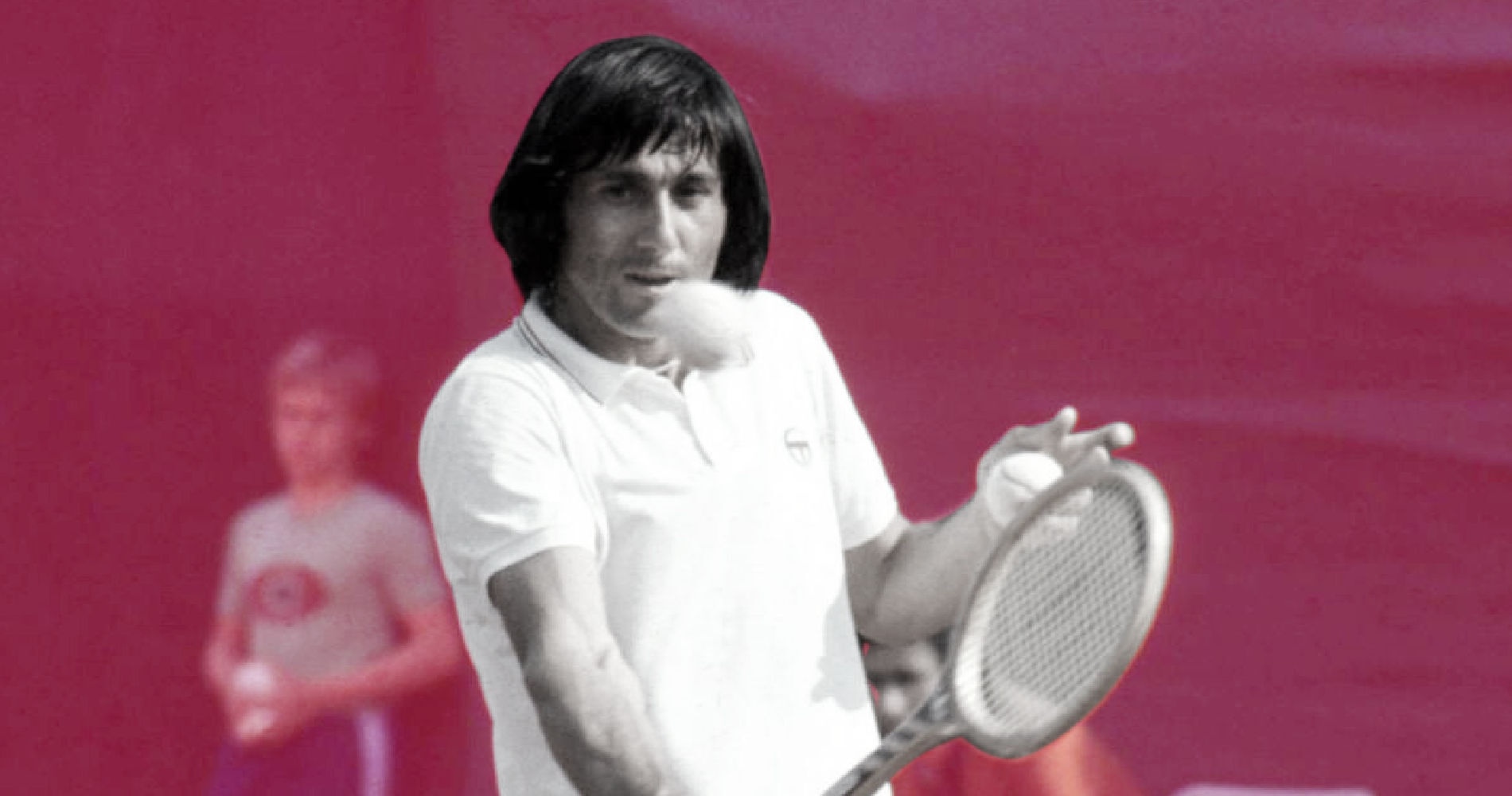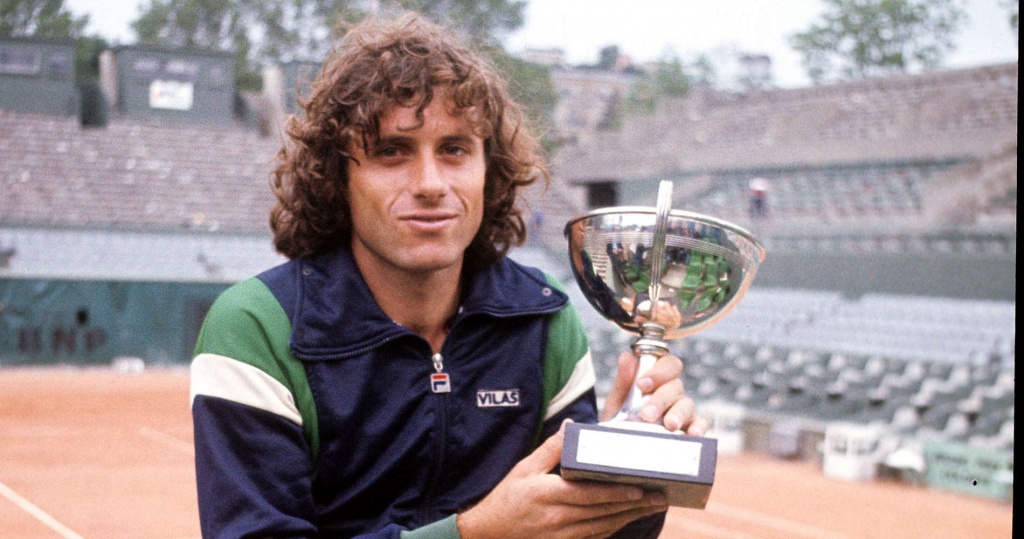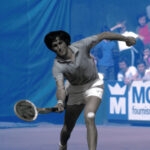October 2, 1977: The day Nastase and his spaghetti racquet frustrated Vilas
Every day, Tennis Majors goes back in time to reflect on a significant event in the tennis world. On October 2, 1977, Guillermo Vilas’ 53-match clay-court winning streak came to an end when he refused to continue playing against Ilie Nastase
 Nastase OTD 10_02
Nastase OTD 10_02
What happened exactly on that day?
On this day, October 2 in 1977, Ilie Nastase used a spaghetti racquet to beat Guillermo Vilas in the final in Aix-en-Provence, putting an end to the Argentine’s 53-match winning streak on clay. Vilas, down two sets to love, walked off the court to protest the use of the racquet – which he claimed gave an unfair advantage to Nastase.
Following a few weeks of controversy, the spaghetti racquet had been banned by the International Tennis Federation (ITF) the previous day — but the ban would take take effect only after the end of the tournament.
The players involved: Ilie Nastase and Guillermo Vilas
Ilie Nastase: the first ever world No 1 when the ATP rankings were introduced
Ilie Nastase, born in 1946, started competing internationally in 1966 – playing doubles with fellow Romanian Ion Tiriac – and he obtained his first breakthrough results in singles in 1969, when he managed to beat great players such as Tony Roche and Stan Smith. He played his best seasons between 1971 and 1976. In those years he was loved by the crowds but despised by most of the other players because of his attitude.
Nastase started by reaching the Roland-Garros final in 1971, when he was beaten by Jan Kodes (8-6, 6-2, 2-6, 7-5). Following another major final defeat at Wimbledon in 1972 (lost to Stan Smith in five sets, 4-6, 6-3, 6-3, 4-6, 7-5), he claimed his first Grand Slam title at Forest Hills a few months later by edging Arthur Ashe (3-6, 6-3, 6-7, 6-4, 6-3).
The next year, after triumphing at Roland-Garros against Nikki Pilic (6-3, 6-3, 6-0), he became the first player to reach the world No 1 spot in the newly established ATP rankings. He would hold on to that spot for 40 weeks.
Nastase obtained his best result at the Masters Cup, a tournament he won four times (1971, 1972, 1973, and 1975). His last great year on the tour was 1976 during which he finished runner-up to Bjorn Borg at Wimbledon (6-4, 6-2, 9-7) before reaching his last Grand Slam semi-final at the US Open (beaten by Borg again, 6-3, 6-3, 6-4). Nastase was known to be a great entertainer, but his unpredictable behaviour was controversial among his peers.
Although the crowds generally liked his antics, he earned nicknames such as “Nasty” or “the Bucharest Buffoon.” Constantly arguing with the officials, he sometimes imitated his opponents, taunting and badmouthing them until they lost their temper.
- Guillermo Vilas: the Argentine with a 53-match winning streak on clay
Guillermo Vilas, from Argentina, was born in 1962. He made himself famous in 1974, winning seven titles – including the year-end Masters Cup, where he defeated Nastase in the final (7-6, 6-2, 3-6, 3-6, 6-4). It was the only tile he claimed that year on a surface other than clay, on which his game was the most effective. Left-handed, Vilas was one of the first players to use massive topspin off both wings.
In 1975, he reached the Roland-Garros final – losing to Borg, the only player who could challenge him in long baseline rallies (6-2, 6-3, 6-4). After being defeated in the US Open semi-finals twice, in 1975 and 1976, Vilas reached his peak form in 1977. That year he dominated the game, triumphing at Roland-Garros (destroying Brian Gottfried in the final, 6-0, 6-3, 6-0) and at Forest Hills, where he beat local favourite Jimmy Connors (2-6, 6-3, 7-6, 6-0).
When Vilas arrived in Aix-en-Provence at the end of September, he had already claimed 11 titles since the start of the year, and by the time he reached the final he had set a new record that would remain unbeaten for decades: a 53-match winning streak on clay courts.

The place: Aix-en-Provence Country Club in France
In 1977, an ATP tournament was held for the first time at the Aix-en-Provence Country Club in the South of France. It had opened in 1962 and a women’s tournament, named “The Golden Racquet,” was established there the same year.
The facts: Vilas walks off the court after losing the first two sets
In the early autumn of 1977, there was a big controversy in the tennis world after some players started using a new instrument called the “spaghetti racquet.” Invented in Germany by Werner Fischer, it had been famously used by Mike Fishbach to defeat Stan Smith at the US Open. The difference was not about the racquet itself, but about the stringing technique.
According to The New York Times, “the elements included nylon strings doubled up, with fish‐test line wound around them six rows vertically and six rows horizontally. Adhesive tape and plastic tubing, resembling macaroni, were used to protect the concoction where the strings cross.”
This double-strung racquet generated such an amazing spin that most of the opponents were incapable of playing their game.
At the beginning of a French autumn clay-court tour, one of the most famous players to become victim of the spaghetti racquet was Nastase, who was unexpectedly defeated by Frenchman Georges Goven – who was using the magic tool. The Romanian heavily protested.
“That’s the first time I’ve played against someone using one of those things,” complained Nastase. “It’s also the last. In future I shall refuse to play. I was running the whole time against Goven. Perhaps I’m not in my best form at the moment, but all the same….”
Less than two weeks later, Nastase changed his mind. If he could not beat players who used the spaghetti racquet, he would join them. On Sunday, October 2, he was in the Aix-en-Provence final facing Vilas – undefeated on clay in 1977. In his hands, Nastase held none other than a spaghetti-strung racquet. Ironically, after many players had voiced their complaints along with his, the spaghetti racquet had just been officially banned by tennis authorities. But the ban would not be in effect until the following Monday.
Vilas, the unofficial world No 1, had battled five sets (6‐4, 6‐7, 6‐7, 6‐3, 6‐1) to defeat another spaghetti-racquet user, Frenchman Eric Deblicker – whom he would have certainly crushed in normal circumstances. This time, though, he was facing Nastase. With the spaghetti model in hand, the Romanian rolled through the first two sets, 6-1, 7-5. Then, as his opponent was about to serve to begin the third, Vilas simply walked towards the umpire chair, gathered his equipment, and left the court.
“I am completely disconcerted and discouraged by the trajectory of those balls,” said Vilas, quoted by The New York Times. “You understand that Nastase, plus the racquet, that’s just too much.”
This was how Vilas, the final victim of the spaghetti racquet, saw his record 53-match winning streak on clay come to an end.
What next? Vilas embarks on another 29-match winning streak on clay
Banned by the ITF, the spaghetti racquet would never cause any more controversy.
Vilas would go on to win 29 more consecutive matches after this awkward loss to Nastase. His record of 53 consecutive matches won on clay would live until 2006, when another left-handed Spanish-speaking player, Rafael Nadal, would surpass it. Vilas would reach two more finals at Roland-Garros, defeated by Borg in 1978 (6-1, 6-1, 6-3) and by Mats Wilander in 1982 (1-6, 7-6, 6-0, 6-4). The Argentine would claim two more Grand Slam crowns, at the Australian Open in 1979 and 1980 at a time when most of the biggest tennis stars were not travelling to Melbourne.
People in this post
More tennis news
Rio Open: Lucky Loser Ugo Carabelli makes semi-finals

“I’m a different player” – Draper relishes chance to face nemesis Rublev again in Doha final

Rio Open: Baez reaches semi-finals

Teen prodigy, Russia, Murray, Olympic medallist: Everything you always wanted to know about Mirra Andreeva (but never had time to find out) – updated after reaching 2025 Dubai final

Andreeva finding the secret to success: “When I don’t think…it’s the best way I can play”






